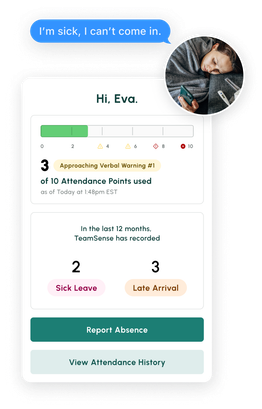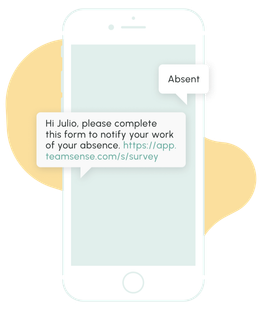Fix the root cause of No-Call No-Show with help from TeamSense
Table of Contents
- The Importance of an Effective Attendance Policy: Why It Matters
- The Costs of Absenteeism: Understanding the True Impact
- Point System vs. Non-Point System Attendance Policies: Which One Is Right for You?
- Point System vs. Non-Point System Attendance Policies: Pros and Cons
- How to Create an Effective Manufacturing Attendance Policy: A Step-by-Step Guide
- What To Include in an Attendance Policy: Essential Elements
- How To Enforce Your Attendance Policy: Best Practices for Success
- Manufacturing Employee Attendance Policy Template
- How To Improve Employee Attendance: Strategies for Success
- Monitoring and Evaluating Your Attendance Policy: Continuous Improvement
- Legal Considerations for Attendance Policies
- Building a Strong Attendance Policy for Your Manufacturing Company
Creating an effective attendance policy that works for everyone in your manufacturing facility can be a tricky task. Whether you're just starting to implement a new attendance policy or need some advice on how to revise it, it's important to understand the elements of what makes an attendance policy successful and ensure that it is fair but also efficient. In this post, we'll provide concrete steps on how to effectively draft an attendance policy in the manufacturing industry so you can keep your staff motivated and productive! Let's dive in and take a look at strategies for making sure your factory runs smoothly with a comprehensive attendance protocol.
The Importance of an Effective Attendance Policy: Why It Matters
When it comes to running a successful human resource department within your manufacturing organization, you can't underestimate the value of a well-structured attendance policy. It's more than just keeping track of who's in and who's out – it has a direct impact on your company's bottom line, work environment, and overall efficiency. Let's take a closer look at some of the key reasons why having an effective attendance policy is so essential:
Operational efficiency
With production lines relying on the coordination of multiple employees, consistent attendance is critical for keeping things running smoothly. When employees are absent, the whole process can be disrupted, leading to delays and increased costs as the line struggles to meet demands.
Workload balance
When someone misses work, their tasks don't simply disappear. Instead, their responsibilities often fall on their teammates, who must shoulder the extra burden. By having a clear attendance policy in place, you help ensure a more equitable distribution of work, ultimately contributing to employee satisfaction.
Stress reduction for leaders
Manufacturing supervisors and managers are under constant pressure to meet production targets, and unexpected absences can exacerbate that stress. A well-implemented attendance policy provides a clear framework for addressing attendance issues and helps reduce anxiety for those in leadership roles.
The Costs of Absenteeism: Understanding the True Impact
It's easy to see that absenteeism can throw a wrench into your manufacturing operation, but the costs associated with it may be more extensive than you initially realize. Let's break down some of the direct and indirect expenses that result from employee absences, as well as how they can affect your overall operations:
- Direct costs: These costs come in the form of expenses related to overtime pay, temporary workers, or even hiring additional full-time staff to cover for absent employees.
- Indirect costs: Absenteeism can lead to reduced productivity, lower quality outputs, and potentially missed deadlines. These indirect costs can have long-term consequences, affecting your company's reputation and profitability.
- Impact on overall operations: Frequent employee absences can create a domino effect that disrupts your entire production process. This may result in delayed shipments, strained relationships with suppliers and customers, and overall inefficiencies.
This is just the tip of the iceberg when it comes to the actual financial impact absenteeism and tardiness has. When looking at ROI, it is often 10x more economical to address absences but utilizing a robust policy in line with a call-off system that works.
Point System vs. Non-Point System Attendance Policies: Which One Is Right for You?
Before we delve into the nitty-gritty of creating an employee attendance policy, it's important to understand the two main types of policies that organizations can choose from: point system and non-point system policies. In this section, we'll provide an overview of each approach and discuss some of the pros and cons to help you determine which one might be the best fit for your manufacturing company:
Point system policy overview: A point system assigns points to employees for absences, tardiness, and early departures. As points accumulate, employees may face disciplinary action or even termination, depending on your company's policy.
Non-point system policy overview: In contrast, a non-point system evaluates each absence on a case-by-case basis. This gives management more discretion when it comes to determining the consequences of absenteeism, which can range from verbal warnings to written warnings or other disciplinary actions.

Point System vs. Non-Point System Attendance Policies: Pros and Cons
When deciding on an attendance policy for your manufacturing company, it's important to weigh the pros and cons of different approaches. Two common approaches are point system policies and non-point system policies. Here's a deeper look at the advantages and disadvantages of each:
Point System Attendance Policies:
Pros:
- Objectivity: Point systems provide a clear, objective method for tracking and evaluating employee attendance. Each absence, tardiness, or early departure is assigned a specific point value, allowing for consistent enforcement and reducing the potential for favoritism or bias.
- Transparency: Employees can easily understand the rules and consequences associated with accumulating points, helping to create a sense of fairness and predictability.
- Motivation: Since point systems often include consequences for reaching certain point thresholds, they can serve as a motivational tool to encourage employees to maintain good attendance.
Cons:
- Rigidity: Point systems can be inflexible, potentially penalizing employees for unavoidable or legitimate reasons for absences, such as emergencies or illnesses.
- Administrative burden: Implementing and managing a point system can be time-consuming and require additional resources for tracking and enforcing the policy.
- Employee dissatisfaction: If not carefully managed, point systems may lead to employee dissatisfaction, as they can feel overly punitive or unsympathetic to individual circumstances.
Non-Point System Attendance Policies:
Pros:
- Flexibility: Non-point system policies allow for more case-by-case evaluation of employee attendance, providing greater flexibility to account for individual circumstances and legitimate reasons for absences.
- Personalized approach: Managers and supervisors can use their discretion to address attendance issues, fostering a more personalized and empathetic approach to employee management.
- Lower administrative burden: Non-point system policies typically require less administrative effort to manage compared to point systems, as there's no need to track specific point values.
Cons:
- Subjectivity: The case-by-case nature of non-point system policies can introduce subjectivity and inconsistency, potentially leading to accusations of favoritism or bias in enforcement.
- Lack of transparency: Non-point system policies may be less transparent to employees, as consequences for attendance issues are not always as clearly defined as in point systems.
- Difficulty enforcing: Without a structured system in place, managers may struggle with enforcing the policy consistently and effectively, potentially allowing attendance issues to persist or escalate.
By carefully considering the pros and cons of point system and non-point system attendance policies, you can determine the best approach for your manufacturing company based on your unique needs and objectives.
What is a "no-fault" attendance policy?
A "no-fault" attendance policy is another approach to managing employee attendance that differs from both point system and non-point system policies. Under this type of policy, employers generally do not assign blame for absences, regardless of the reason. Instead, employees are allowed a specific number of absences within a given period, and once that limit is exceeded, disciplinary action for employee absence may be taken.
The key features of a no-fault attendance policy typically offer a predetermined number of allowed absences, which can include both an excused absence, and unexcused absences. This approach aims to treat all employees fairly by not distinguishing between the reasons for absences.
Pros and cons: No-fault policies can be easier to administer and may be seen as more equitable. However, they may not be as flexible as other policies and could lead to dissatisfaction among employees who feel that their legitimate reasons for absences are not being considered.

How to Create an Effective Manufacturing Attendance Policy: A Step-by-Step Guide
Now that we've covered the importance of attendance policies and the differences between point and non-point systems, let's dive into the process of creating a policy that works for your manufacturing company. Here's a step-by-step guide to help you on your way:
- Assess the current situation: Start by taking stock of your existing attendance policy (if you have one) or the current attendance trends within your organization. Identify any recurring issues, such as chronic absenteeism or confusion surrounding the policy.
- Identify goals and objectives: Establish clear objectives for your attendance policy, such as reducing absenteeism rates, improving employee productivity, or fostering a more positive work environment.
- Involve key stakeholders: Include input from managers, supervisors, the HR department, personnel, and employees to create a well-rounded policy that addresses everyone's concerns and needs.
- Choose between point system and non-point system: Based on your assessment and goals, decide whether a point system or non-point system policy would be the best fit for your organization. Consider the pros and cons of each approach and how they align with your company's culture and objectives.
What To Include in an Attendance Policy: Essential Elements
An effective attendance policy should be clear, comprehensive, and easy to understand. Here are some key elements you'll want to include in your attendance policy template:
- Clear definitions encourage attendance: Clearly define what constitutes an absence, tardiness, early departure, and any other attendance-related terms. This will help minimize confusion and ensure everyone is on the same page.
- Procedures for reporting absences: Establish a clear process for employees to report absences, such as whom to notify and when. This can help streamline communication and reduce misunderstandings.
- Consequences for policy violations: Outline the specific consequences employees can expect if they violate the attendance policy, whether you've chosen a point system or a non-point system approach. Be sure to include progressive disciplinary actions and, if applicable, a termination threshold.
- Support for employees facing challenges: Offer resources and support for employees who may be struggling with attendance issues, such as assistance with childcare, transportation, or a mental health professional for concerns.
- Accommodations for disabilities and other circumstances: Ensure that your policy includes provisions for employees with disabilities, as well as reasonable accommodations for factors like religious observances, family emergencies, or jury duty.
How To Enforce Your Attendance Policy: Best Practices for Success
Creating an attendance policy is just the first step – enforcing it consistently and fairly is equally important. To make sure your policy is effective, follow these best practices for implementation:
Start by clearly communicating the policy to all employees. Distribute the policy in writing, discuss it during team meetings, and consider offering training sessions to ensure everyone understands the expectations and consequences. Transparency is key to getting everyone on board.
Next, apply the policy consistently across all employees, regardless of their position or tenure. Inconsistencies can lead to resentment and undermine the policy's effectiveness, so it's crucial to treat everyone fairly and maintain a level playing field.
Don't forget to periodically review and update your attendance policy. As your organization evolves, you may need to make adjustments to your attendance guidelines to address new concerns or changing circumstances. Regular reviews will help ensure your policy remains relevant and effective.
Finally, provide training for supervisors and managers responsible for enforcing the attendance policy. Equip them with the knowledge and skills they need to understand the rules, consequences, and how to handle unique situations. This will empower your leadership team to handle attendance issues confidently and fairly, ultimately contributing to the success of your policy.

Save Hundreds of Hours A Year With TeamSense
See how TeamSense saved HelloFresh 3-4 hours per day managing attendance through text. Read the case study and book your demo today!
Manufacturing Employee Attendance Policy Template
To help you get started with creating your own attendance policy, here's a template that you can customize to fit your organization's needs:
[Company Name] Attendance Policy
I. Purpose
The purpose of this attendance policy is to maintain efficient operations, productivity, and a positive work environment by promoting regular and punctual attendance among employees.
II. Definitions
a. Absence: Any time an employee is not present for their scheduled work shift. b. Tardiness: Arriving late for a scheduled work shift. c. Early departure: Leaving before the end of a scheduled work shift.
III. Reporting Absences
Employees are required to report absences to [designated person/department] by [specific method] at least [timeframe] before their scheduled shift start time.
IV. Attendance Policy Approach (Point System, Non-Point System, or No-Fault)
[Choose your preferred attendance policy approach and provide a detailed explanation, including any point values, thresholds, or case-by-case evaluation processes.]
V. Consequences for Policy Violations
[Outline the specific consequences for violating the attendance policy, including any progressive disciplinary actions and termination thresholds.]
VI. Support and Accommodations
[Include information about any available resources, support programs, or accommodations for employees with disabilities, religious observances, or other special circumstances.]
VII. Policy Review and Updates
This attendance policy will be reviewed periodically and updated as necessary to ensure its continued effectiveness and relevance.
By using this template as a starting point, you can create an attendance policy that's tailored to your manufacturing company's unique needs and objectives. Remember to involve key stakeholders, communicate the policy clearly, and enforce it consistently to ensure its success.
How To Improve Employee Attendance: Strategies for Success
An effective attendance policy is just one piece of the puzzle when it comes to improving employee attendance. There are additional strategies you can implement to both track attendance and encourage employees to show up for work consistently and on time. To foster a culture of attendance excellence, consider these tips:
Begin by offering incentives to reward employees with outstanding attendance records. Develop a program that includes bonuses, gift cards, extra time off, or other perks that motivate employees to maintain a good attendance record. Recognizing and rewarding employees for their commitment can go a long way in boosting employee morale and dedication.
Prioritizing work-life balance is another essential strategy. Encourage employees to maintain a healthy balance between work and personal life by offering flexible scheduling options, remote work opportunities, and promoting the importance of taking time off to recharge. A well-rested and balanced workforce is more likely to be present and engaged at work.
Building a positive work environment can also have a significant impact on employee attendance. Create a supportive and engaging atmosphere by encouraging open communication, collaboration, and a strong sense of teamwork. A positive work environment can motivate employees to show up consistently and contribute their best efforts.
Providing growth and development opportunities is another way to improve attendance. Employees who feel engaged and see opportunities for growth within the company are more likely to have better attendance. Offer training and development programs, career advancement opportunities, and regular performance feedback to keep employees motivated and invested in their jobs.
Finally, address any underlying issues that may be contributing to frequent absences. This could include resolving workplace conflicts, providing support for personal challenges, or offering resources for employees facing transportation or childcare difficulties. By tackling these issues head-on, you can create a more supportive environment that encourages regular attendance.

Monitoring and Evaluating Your Attendance Policy: Continuous Improvement
Once you've implemented your attendance policy and any additional attendance improvement strategies, it's crucial to regularly monitor and evaluate their effectiveness. By staying on top of your policy and making improvements as needed, you can ensure a more productive and efficient manufacturing operation.
Start by tracking attendance data with an attendance tracking system to collect information on employee attendance, tardiness, and early departures. Regularly review this data to identify trends and areas for improvement. Tracking your employees' attendance patterns can help you better understand the challenges they face and make informed decisions about how to address them.
Gathering employee feedback is another important step in monitoring and evaluating your attendance policy. Encourage employees to share their thoughts and experiences, as their feedback can help you identify any issues or areas where the policy could be adjusted to better meet the needs of your workforce.
Measuring the effectiveness of your attendance policy is also essential. Compare key employee performance and indicators (KPIs), such as absenteeism rates, productivity levels, and employee satisfaction, before and after policy implementation. This will give you a clear picture of how your policy is impacting your organization and help you identify areas where it may need fine-tuning.
Lastly, adjust and refine your attendance policy as needed. If your evaluation reveals areas where your policy could be improved, make the necessary adjustments and continue monitoring its effectiveness. Remember that an attendance policy should be a living document that evolves with your organization's needs and goals. By continuously improving your policy, you can create an environment that promotes better attendance and higher productivity.
Legal Considerations for Attendance Policies
When creating and enforcing your attendance policy, it's essential to be aware of the legal considerations and requirements that may apply. While this is not an exhaustive list of legal liability, here are some key areas to keep in mind:
- Fair Labor Standards Act (FLSA): Ensure your policy adheres to the FLSA guidelines, including rules related to minimum wage, overtime pay, and recordkeeping. Be particularly cautious when it comes to docking pay or denying overtime for poor attendance-related reasons.
- Family and Medical Leave Act (FMLA): If non exempt employee of your organization is covered by the FMLA, your attendance policy must accommodate eligible employees who need to take job-protected, unpaid leave for qualified medical and family reasons.
- Americans with Disabilities Act (ADA): Your policy should include provisions for employees with disabilities and be compliant with the ADA. Make reasonable accommodations for employees with disabilities that may affect their attendance, such as modified work schedules or additional medical leave.
- State and local employment laws: Be aware of any state or federal laws or local laws that may impact your attendance policy, such as paid sick leave requirements, pregnancy leave, or other employee leave protections. Consult with legal counsel to ensure your policy complies with all applicable laws and regulations.
Building a Strong Attendance Policy for Your Manufacturing Company
Developing and implementing an effective attendance policy is a crucial component of maintaining a productive and efficient manufacturing operation. By considering the various policy approaches, involving key stakeholders, and carefully crafting a policy that meets your organization's unique needs, you can reduce absenteeism and create a more positive work environment.
Remember to communicate the policy clearly, enforce it consistently, and regularly review and update it to ensure it remains relevant and effective. Additionally, consider implementing strategies to improve employee attendance beyond the policy itself, such as offering incentives, promoting work-life balance, and addressing underlying issues.
By taking a comprehensive and thoughtful approach to attendance management, you can help your manufacturing company thrive and maintain a competitive edge in the industry.

Save 120+ Hours A Year With TeamSense
See how TeamSense saved HelloFresh 3-4 hours per day managing attendance through text. Read the case study here and book your demo today!
About the Author

Sheila Stafford, CEO of TeamSense & AI in HR Innovator
As CEO of TeamSense, Sheila Stafford is at the forefront of transforming HR for frontline teams through AI-driven solutions. With a commitment to enhancing employee relations and simplifying workforce management, Sheila leads TeamSense in pioneering advancements that empower both frontline employees and HR teams. Her visionary approach combines cutting-edge technology with a thoughtful focus on enhancing human connection; Sheila strategically implements AI where it adds the most value while recognizing the critical role of personal interaction and ensuring that human engagement remains central when it matters most. Under her leadership, TeamSense is redefining how companies support and engage their frontline teams for a more connected, efficient workplace.





